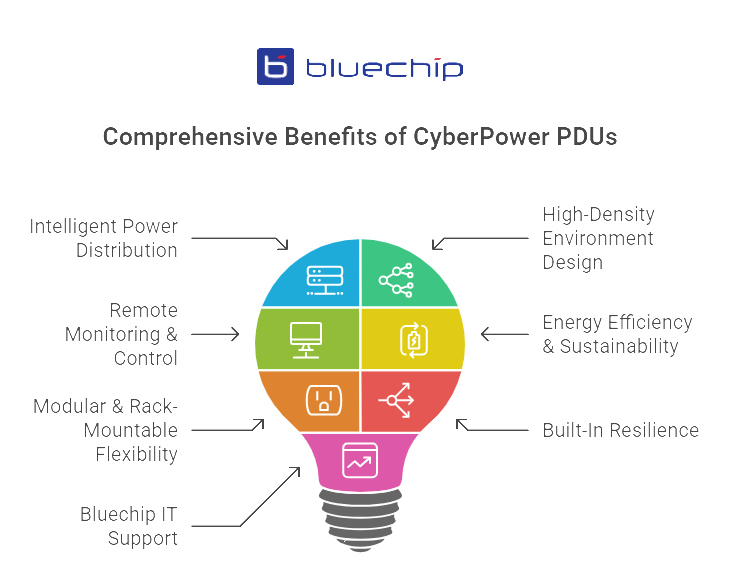In 2025, power infrastructure for racks is no longer simply about “plugging in a strip and forgetting it.” With ever-rising computer density, edge deployments, and hybrid architectures, rack power management has become a critical strategic concern for resellers, MSPs, and their clients.
A Power Distribution Unit (PDU) is essentially the backbone of rack-based power delivery, distributing electricity to servers, storag,e and networking equipment in a rack, while increasingly offering monitoring, control, and integration capabilities. Technological evolution and higher power demands are reshaping how we approach PDUs, rack power management, and data centre reliability.
At Bluechip IT, as an Australian distributor of CyberPower’s intelligent rack-mountable PDU solutions, we’re seeing firsthand how resellers/MSPs are responding to these changing demands. In this article, we’ll walk through the key rack power-management trends to watch in 2025, so you can position your offering, support your clients, and stay ahead of the curve.

Evolving Demands in Rack Power Management
The first major shift in rack power management stems from rising hardware density. As data centres expand to support AI workloads, edge computing, and high-performance applications, the power draw per rack has grown dramatically.
According to CoreSite (2024), the average rack power density in traditional data centres sits around 15 kW per rack, but AI-centric racks can demand between 60 kW and 120 kW in advanced deployments.
This surge in consumption means Power Distribution Units (PDUs) must evolve from basic power strips into intelligent, high-capacity systems capable of managing higher amperage, multi-phase configurations, and automated load balancing.
Modern rack environments also demand real-time visibility, energy monitoring, and remote control. Where once PDUs merely distributed electricity, today they serve as data-driven infrastructure components that optimise uptime, efficiency, and sustainability.
For resellers and MSPs, this evolution transforms rack power management from a routine necessity into a strategic opportunity. Clients now expect solutions that combine power delivery, insight, and resilience, and intelligent PDUs are becoming essential to meet these expectations.
Trend #1: Rise of Intelligent & Metered PDUs
One of the most pronounced trends in 2025 is the shift from basic, unmanaged PDUs to intelligent and metered PDUs. These units provide features such as load-balancing across outlets, energy measurement in real time, remote control of outlets, and alerts when thresholds are exceeded. The benefits are clear: higher efficiency, better uptime, fewer surprises.
For example, a managed PDU can allow you to turn off idle equipment remotely. Also, avoid overloading a circuit, and get an early warning of an impending rack power fault. In a world where every minute of downtime is costly, these capabilities matter.
Looking ahead, adoption of metered/switched PDUs is expected to rise as organisations invest in smarter infrastructure. Vendors such as CyberPower are offering rack-mount PDU units with network connectivity, outlet-level switching, and monitoring, making them a strong fit for resellers and MSPs to offer modern power solutions.
Trend #2: Higher Power Density & Advanced Load Management
Another pressing trend is higher power density in racks. As noted above, AI workloads and GPU servers are driving per-rack consumption from traditional levels to tens of kilowatts. Some forecasts also point towards 50 kW per rack by 2027.
This means that PDUs must support higher amperage, multi-phase power (e.g., 208 V/230 V), better thermal management, and balanced loads. In addition, “rack power management software” becomes vital: being able to track usage trends, identify hot spots, and plan capacity ahead of time.
For resellers/MSPs, selling the right PDU for these high-density racks means advising clients on future proofing, not simply covering today’s load.
Trend #3: Integrated Networking and Remote Monitoring
A third trend: PDUs are increasingly becoming network-aware. Features like Ethernet ports, SNMP support, API integration, and remote dashboards are now expected. This is especially relevant in distributed, hybrid, or edge-based environments where racks may sit in remote locations.
For MSPs, this capability means being able to monitor and manage client racks proactively. While turning power outlets on/off remotely, receiving alerts before issues escalate, and including PDU networking as part of your managed services offering. In 2025, networked PDUs are becoming the standard for distributed power-infrastructure management.
As an example use-case: an MSP managing multiple edge server racks across locations can deploy rack-mountable PDUs with remote monitoring, integrate them into their NOC dashboard, and reduce on-site interventions.
With CyberPower’s intelligent and rack-mountable PDUs available through Bluechip IT, resellers can offer their clients seamless, network-ready power infrastructure designed for reliability and control.

Trend #4: Focus on Energy Efficiency & Sustainability
Sustainability and energy efficiency are no longer nice-to-haves; they’re strategic. Data-centre operators and large enterprises are under pressure to reduce energy waste, track consumption closely, and meet carbon commitments. In this context, PDUs with metered power tracking, efficiency monitoring and eco-design features are increasingly desirable.
For instance, by tracking outlet-level consumption and correlating it with workload, organisations can optimise utilisation and reduce wasted capacity. Some sources indicate that improved power and cooling-management can reduce energy usage by 20-40%.
For resellers/MSPs, this means an opportunity. Positioning PDUs not only as uptime protection, but as a part of the energy-efficiency and sustainability story your clients care about.
Trend #5: Modular & Rack-Mountable Designs for Flexibility
Flexibility is also a key trend. With mixed vendor racks, varying outlet types, and edge deployments, modular and rack-mountable PDU designs are gaining favour. These designs simplify installation, reduce deployment time, and fit neatly into standard rack ecosystems.
For example, standardising on rack-mount PDUs and offering modular extensions helps resellers/MSPs deploy power infrastructure more quickly and reliably. It also reduces complexity when clients change or expand their rack footprint.
In 2025, PDUs that support easy installation, hot-swap modules, plug-and-play configurations, and mixed outlet types will differentiate in the market.
Trend #6: Enhanced Power Resilience and Redundancy
As uptime demands escalate, so does the need for power resilience. This includes the use of redundant PDUs, dual-input power feeds. As well as integration with Automatic Transfer Switches (ATS) to ensure uninterrupted power in maintenance or fault scenarios.
In 2025, we’ll see more PDUs designed to operate through maintenance. Thus, shifting power sources seamlessly and providing built-in resilience in mission-critical racks.
For MSPs/resellers, offering PDUs with built-in redundancy becomes a key selling point for high-availability environments such as data-centres, branch networks, or edge-compute sites.
Trend #7: Smarter Data and Predictive Analytics
Finally, the future is about data. Advanced PDUs are becoming data-sources themselves, collecting granular metrics (voltage, current, power factor, temperature) and feeding analytics engines. The next frontier: integration with AI-driven predictive models that forecast usage trends, identify anomalies, and trigger maintenance before failures.
In 2025, expect PDUs to be embedded into infrastructure-management workflows: power data becomes part of capacity-planning, cooling-optimisation, and resource allocation. For resellers/MSPs, this translates into new services: offering analytics, reports, and optimisation insights along with the physical PDU hardware.
To clarify PDUs’ meaning, they refer to Power Distribution Units that manage and distribute electrical power within a rack setup, ensuring balanced and efficient energy delivery to all connected devices.

How CyberPower & Bluechip IT Support These 2025 Trends
At Bluechip IT, we partner with CyberPower to help resellers and MSPs access the rack power solutions aligned with these trends. CyberPower offers intelligent and rack-mountable PDUs with metering, network connectivity, outlet-level control, and modular design. Through Bluechip IT, you have access to local stocks in Australia. As well as partner pricing and technical support to deploy these technologies quickly and effectively.
Whether your clients need metered PDUs for efficiency or switched PDUs for remote control. Also, redundant PDUs for high-availability, CyberPower (via Bluechip IT), have the right model. By aligning these solutions with the trends above, resellers and MSPs can future-proof their offering. They can also differentiate themselves from the competition and deliver more value to clients.
Empower Your Clients with Smarter, Sustainable Rack Power Solutions
In summary, rack power management is no longer an afterthought in 2025. The convergence of rising rack densities, smarter PDUs, and network integration. As well as sustainability mandates, modular design, resilience requirements, and data-driven analytics mean that the PDU has become a strategic component of IT infrastructure.
By adopting intelligent, networked, and efficient PDUs, your clients’ systems can achieve higher uptime, better efficiency, and long-term sustainability. For resellers and MSPs, now is the time to elevate your offering. Recommend PDUs not just as “power strips” but as vital tools for performance and reliability.
Bluechip IT, together with CyberPower, empowers partners across Australia to deliver advanced power distribution units for server rack solutions that meet these evolving needs.
Stay Ahead with Smarter Rack Power Solutions
Discover how CyberPower’s intelligent and rack-mountable PDUs can help you deliver greater efficiency and reliability. Gain deeper power insight for every rack you manage, available exclusively through Bluechip IT.
